You’d love to spend every moment at home, snuggling and playing with your dog. But real life doesn’t work that way. You have a job. Not to mention other responsibilities. That means time when you need to leave your beloved pup on their own. And while you CAN leave your dog free to roam the house or apartment, that isn’t always the best idea. You may come home to chewed furniture, accidents on the floor, or a note from your neighbor about excessive barking. Dog crates are the best solution to keeping your pup calm, quiet, and out of trouble.
Crating
Crating dogs produces controversy among pet owners. Some people feel dog crates are cages and cruel. This is understandable as the design of a kennel DOES resemble a cage, but that’s where the similarity ends. Dogs LIKE crates. And when you train them to use a kennel, you’re working with a primal instinct wired into the canine brain.
In the wild, wolves and other wild canids seek dens. A cave or other shelter represents a place of safety and comfort. That’s where the pack meets at the end of the day to eat and sleep. It’s protected from threats. And dog crates? Those are dens for our modern canine companions.
Benefits of Dog Crates
Veterinarians and dog trainers alike champion the use of crates. That kennel represents a tool for:
- Helping you with housebreaking
- Providing shelter during parties or other loud activities
- Preventing your dog from getting into trouble
- Giving your pup somewhere uniquely theirs
And while no one wants to contemplate their dog needing a surgical procedure, the possibility exists. Recovery often requires cage rest. As Dr. Lisa Lippman of Animal Lighthouse Rescue points out, “If your dog should ever need to be contained for medical reasons, having them already used to spending time in a crate is essential.”
Types of Dog Crates
Every dog is different. And the pet market recognizes that by crafting different types of dog crates. Some work well for occasional use, others for regular habits. You can pop some into the car without a problem, while others won’t travel well. Certain materials hold up to an inquisitive nibble, while others will come apart. You need to understand your dog’s behavior to figure out which type will work best.
- Metal: For dogs that bull out of every kennel, metal is the way to go. The steel construction resists teeth, feet, and muscle. They’re HEAVY, though. These crates are considered indestructible.
- Plastic: If you want to travel, plastic dog crates work well. They’re lightweight, with wire panels for ventilation. However, you won’t find them easy to clean, and they restrict visibility. The plastic sides also trap air, allowing your dog to heat up in warm weather.
- Soft: As long as you don’t have a chewer, soft sides work well. These crates usually collapse, making them portable and convenient to take anywhere.
- Wire: The majority of dog crates are wire. They offer complete visibility and plenty of airflow. They also have a tray to make cleaning easy. And since they collapse, you can take them with you – if you have the room.
- Wood: This is another material that’s BAD if you have a chewer. But when you want a dog crate that looks classy, this is the way to go. These kennels often resemble end tables, integrating into the home beautifully.
Choosing a Dog Crate
Once you’ve settled on the type of dog crate that works best for your dog (and you), it’s time to look at the essential features. There are THOUSANDS of kennels out there, and some are built better than others. You don’t want to keep running to the pet store for replacements, so it’s important to do a little homework and get the best one on the first try.
- Size: Bigger is NOT better when it comes to dog crates. Your pup should be able to stand (without hunching), lay down with every limb stretched out, and turn around. That’s IT. Anything else is too big.
- Safety: If you know your dog loves to chew, skip the soft sides and wood. You also want to look at the space between wires and make sure your pup can’t get a paw stuck.
- Portability: Are you comfortable with the dog crate staying in one place? Or do you want to take it on trips and move it around the house? This may mean a foldable option or casters.
- Cleanliness: Even if your dog’s housebroken, accidents happen. How easy is that dog crate to clean? Some come with trays that slide out, and others have washable materials.
Considerations with Dog Crates
Crating makes dogs feel at home. It gives them somewhere to retreat when they’re uncomfortable. For instance, our Greyhound is terrified of flies. (We don’t know why) Whenever one gets in the house, she books it for her crate until our feline fly-catcher eliminates the “threat.” Once you train your dog to recognize the kennel as theirs, you’ll see similar patterns.
However, you need to keep some things in mind when you use a dog crate.
First, dogs shouldn’t wear collars inside. Regardless of which type of kennel you choose, the collar can catch on the bars. When you escort your dog into their crate, remove the collar and set it nearby. Then you can replace it when they exit.
Second, if you’re starting to crate-train a puppy, look for a dog crate with dividers. The kennel will grow with your dog. This beats buying new crates over and over. And you don’t want to buy an adult crate – that’s too large.
Third, don’t crowd the kennel. If you add in too many toys or bowls, you’ll leave no room for your pup! A dog crate isn’t meant to serve as a playpen. One toy (provided your dog doesn’t have a history of destruction) is sufficient.
Best Dog Crates
Dog crates HELP our canine companions. That simple kennel provides so many benefits. Whenever they feel uncertain or frightened, they have somewhere safe to retreat to. And with the proper bed or mat, you can make the crate comfortable. They’ll settle down, sleep, and stay OUT of trouble. Then you can step out with relief.
Best Soft-Sided Dog Crates
Soft-sided dog crates come in with the LIGHTEST weight (provided your dog isn’t inside). It’s a cinch to collapse them down, pop them into the back of the car, and go camping or off to visit relatives. The sides feature panels that roll up or down, giving your dog better privacy when they need it. However, the fabric WON’T hold up to teeth or claws. And if you don’t weigh it down, it’s easy for your pup to tip themselves over. You also won’t find a tray in the bottom, so make sure you have a stash of puppy pads handy, just in case.
2Pet combines a rigid steel frame with 600D Oxford nylon, creating a sturdy soft-sided dog crate. Your canine companion gets four mesh windows for viewing and ventilation. The front zipper is protected from curious puppy teeth, so you don’t need to worry about escapes. And when you want to move the crate, there’s a handle on the top. You also get the bonus of water and food cups in the back when you’re traveling. And 2Pet offers a one-year manufacturer’s warranty.
Downsides? While nicely providing ventilation, the mesh tears easily. And if you have a determined dog, they can easily muscle their way out of the sides. This is a better idea for calm, relaxed dogs.
The Good
- Steel frame with 600D Oxford nylon
- Protected zipper
- Available in 5 sizes
- Available in 4 colors
- 1-year manufacture's warranty
The Bad
- Mesh tears easily
- Not designed for strong dogs
For quick and easy use, Amazon Basics delivers a soft-sided dog crate crafted from a PVC frame stretched over polyester fabric. Your dog still gets mesh windows on all four sides, and straps keep any rolled doors out of the way of curious teeth and paws. When you want to move the crate, it folds flat for easy transport. It comes in five sizes, designed to work for even giant breeds. And Amazon throws in a one-year limited warranty.
The downsides? Polyester isn’t designed to take abuse. Any pressure, and your dog can go straight through it. And that goes double for the mesh. This is NOT a dog crate for pups that get distracted by things. Also, you definitely want to invest in a bed, or a pile of blankets as the cross-bracing is uncomfortable for a canine to lay on.
The Good
- PVC frame with polyester
- Straps to hold rolled doors
- Available in 5 sizes
- 1-year limited warranty
The Bad
- Polyester tears easily
- Mesh tears easily
- Cross-bracing uncomfortable for dog to lay on
Why not go for maximum comfort with your soft-sided dog crate? EliteField starts with a steel frame and 600D nylon, then they add THREE mesh doors, a washable fleece bed, pockets to store treats or toys, AND a carrying bag. The windows are a stronger hex mesh that gives your dog a clear view around them. They also add in zipper locks to keep them away from curious canines. And EVERYTHING’s washable, just in case. You have a whopping SIXTEEN colors to choose from in five sizes. And EliteField throws in a TWO-YEAR warranty.
So what are the downsides? While sturdier than other dog crate meshes, the mesh still presents a point of weakness. And the zipper locks are plastic, so they CAN break with enough pressure. Soft-sided kennels are NEVER good ideas for strong, nervous, or determined dogs.
The Good
- Steel frame with 600D nylon
- Hex mesh
- Zipper locks
- Attached pockets
- Carrying bag
- Available in 5 sizes
- Available in 16 colors
- 2-year warranty
The Bad
- Mesh tears easily
- Zipper locks break
Noz2Noz is another soft-sided dog crate that uses powder-coated steel for the frame. But they go the extra mile by using a water-resistant base – in case those accidents happen. This means an easy clean-up for you. (And, of course, the entire cover can go in the wash, if you need) The tight-weave mesh allows plenty of ventilation through every side. And if you’re using the kennel around the house? They have rounded corners designed to prevent bumped hips and legs.
Downsides? There’s Velcro around the zippers – but it’s not attached well. If you pull too hard, you’ll tear the fabric. Unlike most other soft-sided options, you don’t get a mesh panel on the top. Instead, it’s simply a door. Not necessarily a deal-breaker, but something to keep in mind.
The Good
- Steel frame with 600D nylon
- Water-resistant base
- Available in 5 sizes
The Bad
- Mesh tears easily
- Pulling on Velcro can tear fabric
- No mesh panel in top
Steel and tight-weave mesh construct PetNation’s soft-sided dog crate. The doors come with handy fasteners when you want to roll them out of the way. And they make sure you have industrial-strength zippers (just in case). It’s a cinch to collapse out of the way, and the straps hold it into a neat roll. And you don’t need to worry about your dog lying on any of the braces.
The downsides? The mesh panels are on the smaller side, which may help prevent escapes (well, except for the main door). And while they HAVE upgraded their zippers, they don’t keep them out of reach of curious puppy teeth. Make sure you monitor where the zipper goes when you close things up.
The Good
- Steel frame with tight-weave mesh
- Industrial-strength zippers
- Available in 5 sizes
The Bad
- Mesh tears easily
- Less ventilation
- Zippers not locked
Best Wire Dog Crates
Wire dog crates show up pretty much everywhere. Boarding facilities use them, they’re a staple at veterinary clinics, and you see them behind-the-scenes at dog shows. Why? Because you get an unobstructed view of your dog. They also allow the best airflow, keeping pups cool (or warm), no matter where they’re at. With handy trays in the bottom, it’s easy to keep the kennels clean. And they fold flat, so you can move them out of the way or bring them with you on trips. But they ARE heavy, and it can get tricky to find somewhere to place them. And for anxious dogs, all of that “open” space may be too much.
Carlson works on the principle that simple is best. They use steel wire with a rust-resistant coating that lets you move this dog crate inside or outside without a problem. The removable tray in the bottom makes cleaning easy, even if you’re only picking up a dropped treat or two. The slide locks stay out of reach of curious paws, but they’re easy for you to manipulate. You can easily fold it flat when you want to get it into the car. And you have five convenient sizes to choose from.
Downsides? Unfortunately, this isn’t as durable as other wire dog crates on the market. The wires WILL bend with a determined pup. This means they may also get a paw stuck. And while it collapses, it doesn’t come with a carrying handle, making it awkward to transport.
The Good
- Steel wire with rust-resistant coating
- Removable tray
- Slide locks
- Folds flat
- Available in 5 sizes
The Bad
- Not durable
- Wires bend
- No carrying handle
Most dog owners are familiar with the MidWest brand. They’re tops in dog crates and bedding. For people with growing puppies, their Life Stages wire dog crate is an excellent choice. They use heavy-gauge steel and tight wire mesh to ensure the crate remains sturdy. Then they include a divider that allows you to adjust the size as your puppy grows. The sides feature rounded clips that eliminate sharp edges seen in other wire kennels, and the bottom has roller feet to protect your floors. You still get handy slide locks and a tray, of course. And when it’s flat? There’s a handle to help with transport.
The downsides? This IS a sturdy crate option, but the wire is on the thinner side, with wider spaces. You’ll want to make sure your dog’s paws don’t fit through. And while one of the lighter MidWest models, this is still a HEAVY crate. The medium size weighs 25 pounds. You may not want to carry it around. Also, your dog CAN push the tray out if they dig around.
The Good
- Heavy-gauge steel and tight wire mesh
- Divider panel
- Removable tray
- Slide locks
- Roller feet
- Folds flat
- Carrying handle
- Available in 5 sizes
The Bad
- Heavy
- Thinner wire
- Wider spaces between wire
- Dog can push out tray
For genuine strength in a wire dog crate, you want MidWest’s Ultima Pro. They use the same heavy-gauge steel and thick wire as their other kennels but in a tighter configuration. The removable tray stays firmly in place until YOU decide to slide it free for cleaning. And you still get the slide locks, roller feet, divider panel, and carrying handle you find in other models. It’s simply a step up in terms of strength. And it comes with a one-year manufacturer’s warranty, just in case.
So what are the downsides? This dog crate is HEAVY. All of that reinforced wire means extra weight. You’ll get a sturdy kennel, but you’ll want to lift with your knees when you decide to move it. You also need to make sure you get the clamps in place when folding it, or it’ll pop open.
The Good
- Heavy-gauge steel and thick wire mesh
- Divider panel
- Removable tray
- Slide locks
- Roller feet
- Folds flat
- Carrying handle
- Available in 5 sizes
The Bad
- Heavy
- Check clamps to prevent opening when folding flat
New World uses a standard wire construction with rounded corners to keep you and your dog safe. The tray includes a stop to prevent your pup from kicking it loose. And the slide bolts secure the single or double doors with ease (you can choose one or the other). The entire dog crate collapses down, and they offer a carrying handle to make transportation a breeze. You get five sizes to choose from, and this option WON’T break the bank.
Downsides? Not all wire is created equal. You’re not getting heavy-gauge steel with this dog crate, and it shows. Plenty of dogs bent the frame out of position or even managed to escape. And while it’s lightweight, that means it’s easier for your dog to shift it around. This option works for dogs that remain calm and only want to sleep in their kennel.
The Good
- Standard wire
- Removable tray
- Slide locks
- Folds flat
- Carrying handle
- Available in 5 sizes
The Bad
- Not durable
- Wires bend
Most people reserve plastic kennels for air travel or their strongest dogs. However, Pet Gear offers a dog crate with wire AND plastic. The sides feature steel wires that provide plenty of ventilation and a clear view for your dog. All FOUR of them open (and so does the top), with the side swinging up like a garage door. You get steel locks on all of the doors, keeping your dog safely inside. The plastic frame has rounded corners for your comfort. There’s a handle built into the top and wheels in the bottom. And when you want to travel? It folds down and tucks into a travel bag. Best of all, it comes with a cushy bed for the bottom!
The downsides? Plastic and dogs that chew or have strength are a TERRIBlE combination. And you find plenty of plastic pieces on this crate, including the latches. They tend to break. That’s assuming you get it assembled in the first place, which plenty of people struggled with. And, again, this dog crate’s HEAVY. You do have wheels, but you don’t get the benefit of wheeling it around when it’s in the travel bag.
The Good
- Plastic and steel wire
- Folds flat
- Built in handle and wheels
- Dog bed included
- Travel bag
- Available in 3 sizes
The Bad
- Heavy
- Not durable
- Plastic breaks
- Difficult to assemble
Best Wood Dog Crates
Admittedly, most dog crates don’t look attractive. And that’s why many owners shy away from them. They don’t want to have a “cage” in their living room. And that’s where wood dog crates come in. You still give your dog the benefits of a den and a place to call their own, but with a more decorative appearance. Many of these kennels resemble furniture, blending into the decor. However, wood is NOT a good choice for dogs that like to chew. Not only will you find yourself without a crate, but you could also end up with a canine in the hospital. You also limit the ventilation and visibility offered to your pup.
Casual Home creates stunning wood dog crates from solid hevea wood. The delicate latticework looks beautiful in any home, and no one would even suspect it was a kennel! The top can support up to 120 pounds (or 200 if you buy the XL), allowing you to add knick-knacks or books as you see fit. And you can choose from three colors to make sure you coordinate with the look of the house.
Downsides? You don’t get a tray in the bottom. You’ll absolutely want to have puppy pads lining the bottom. Also, the lock is NOT difficult for a clever dog to manipulate. You could come home to find your pup sleeping on the couch instead.
The Good
- Solid hevea wood
- Supports 120-200 pounds on top
- Available in 4 sizes
- Available in 3 colors
The Bad
- No removable tray
- Easy lock for dogs to open
Worried about possible splinters in case your dog decides to chew on their new kennel? New Age offers a solution. They use ECOFLEX. This composite combines recycled plastic and reclaimed wood to create a polymer that won’t split, warp, or crack, offering you some peace of mind. It’s completely non-toxic (though you still don’t want your dog to eat it). The spindles and latches of the dog crate are stainless steel tubing, providing additional strength. You don’t need special tools to put it together, and it comes in four colors to help you coordinate the look with your home.
The downsides? While ECOFLEX won’t absorb odors, it’d still be nice if you had the tray it DOESN’T come with. And while the material’s stronger than wood, dogs CAN still destroy it. You also have a simple lock dogs can manipulate – even without advanced doggie degrees.
The Good
- ECOFLEX and stainless steel tubing
- No tools needed for assembly
- Available in 4 sizes
- Available in 4 colors
The Bad
- No removable tray
- Easy lock for dogs to open
Safe and Sound
While it’s difficult to deny that dog crates LOOK intimidating, they provide more positives than negatives. Replicating a natural den that canines crave, that kennel is the perfect place for your pup to retreat to when things are hectic around the house. And when you have to head out to work or on errands? A dog crate can help keep your dog out of potential trouble.
Once you work on crate training, you’ll wonder how you – and your furry friend – ever managed without one.

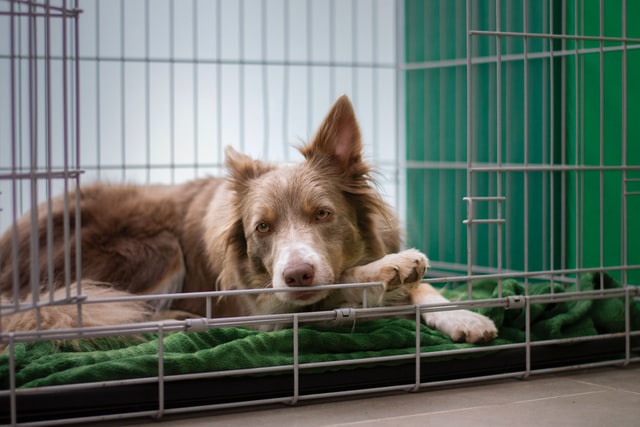
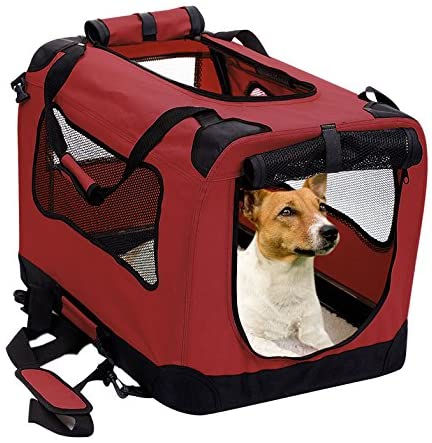

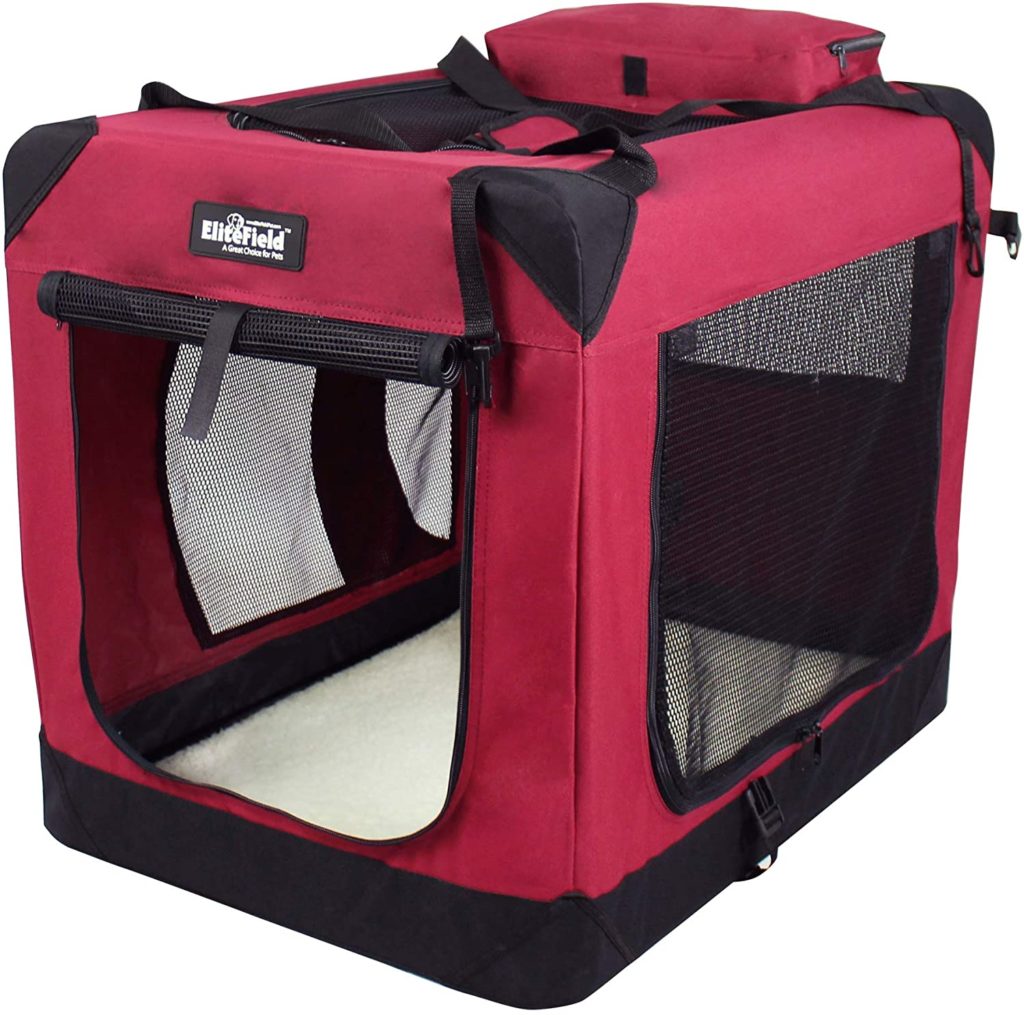
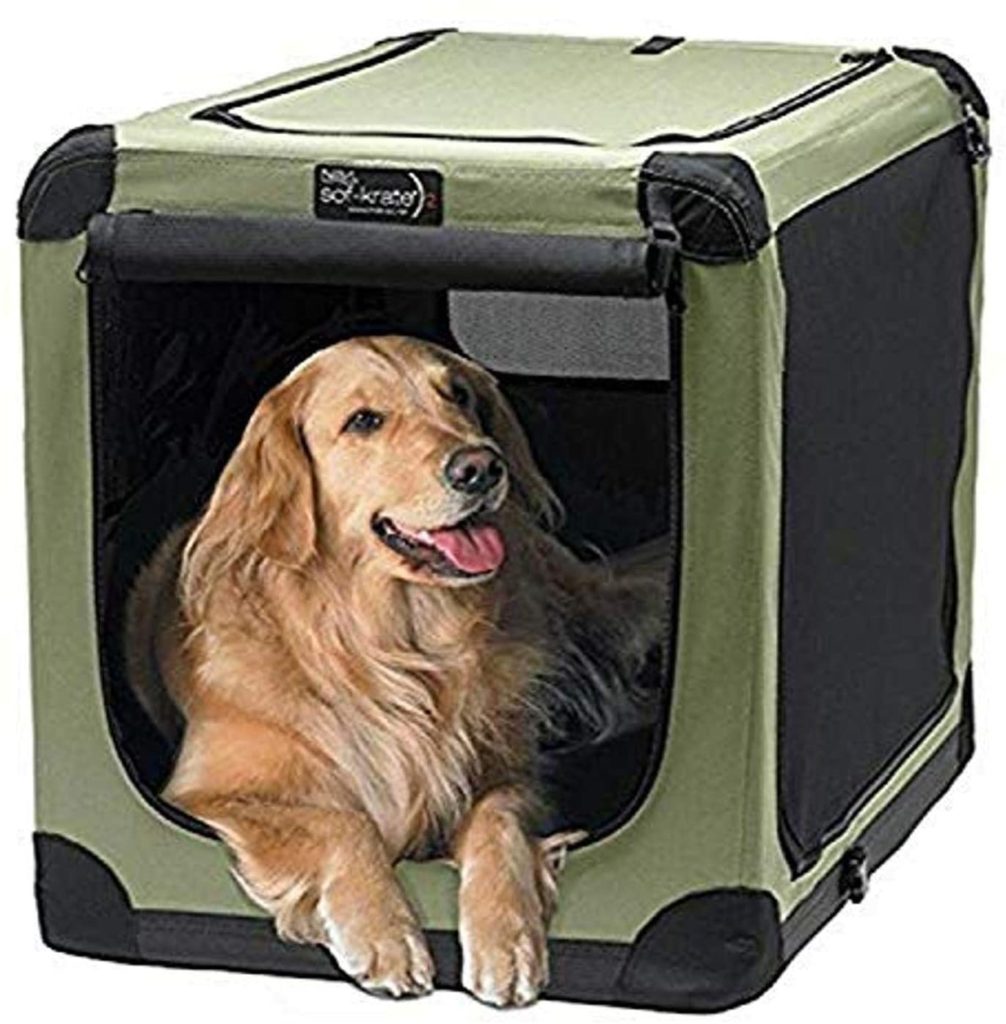
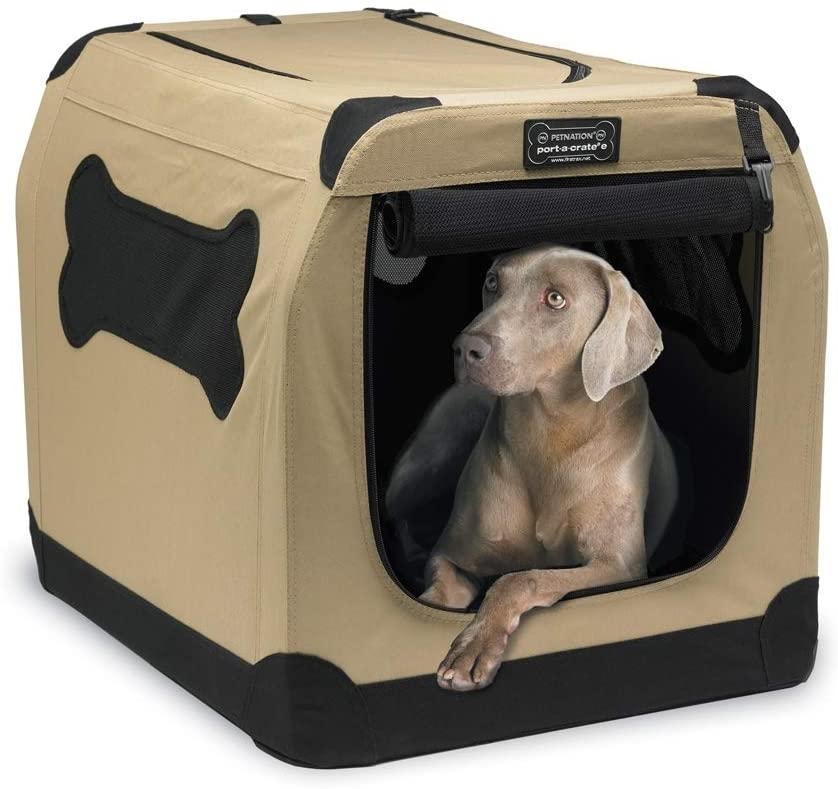
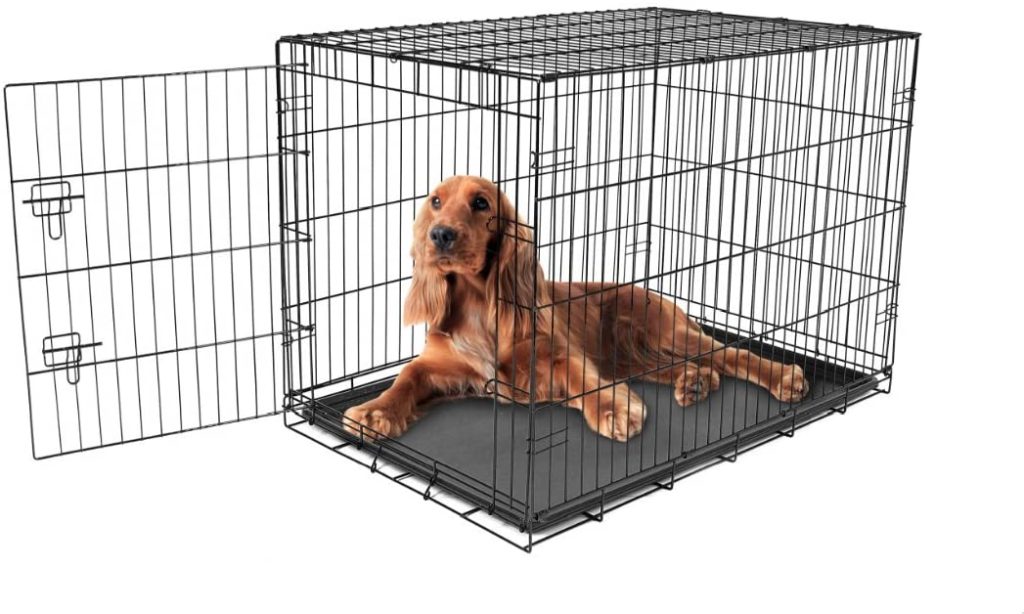
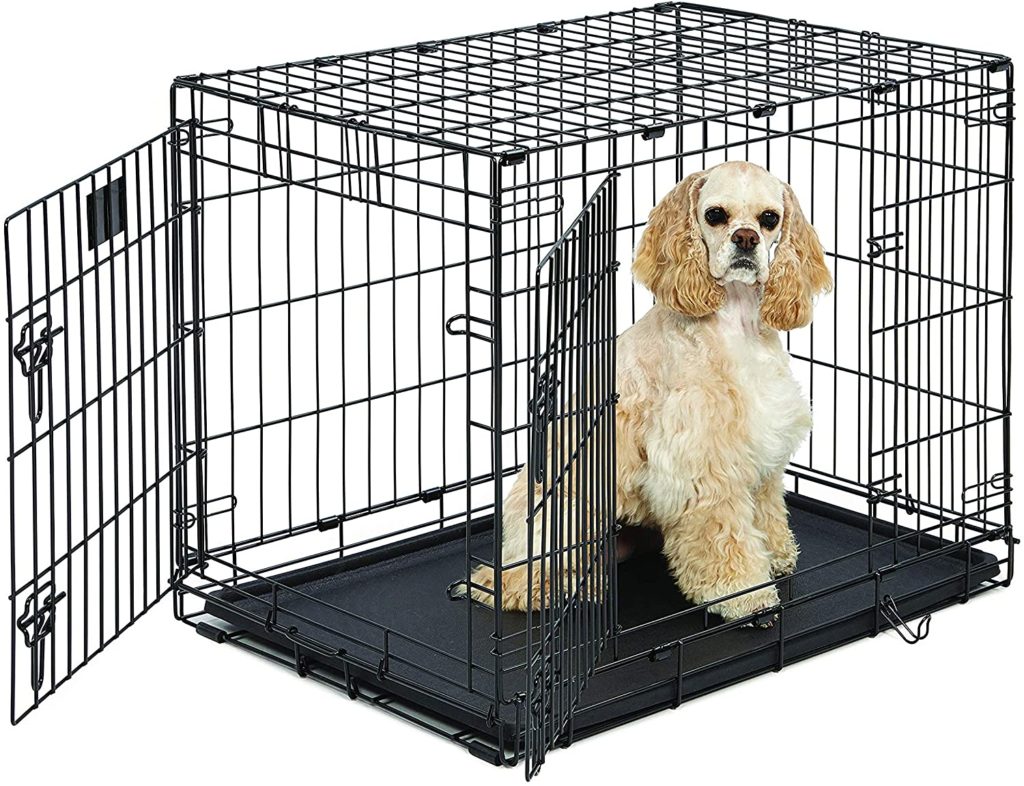
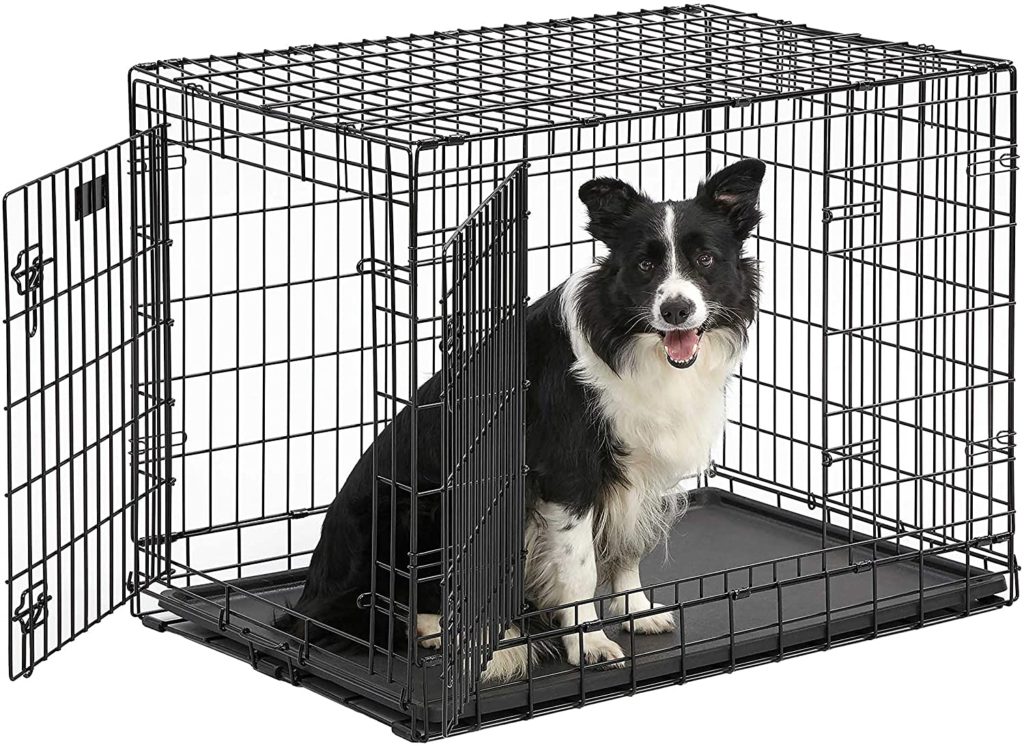
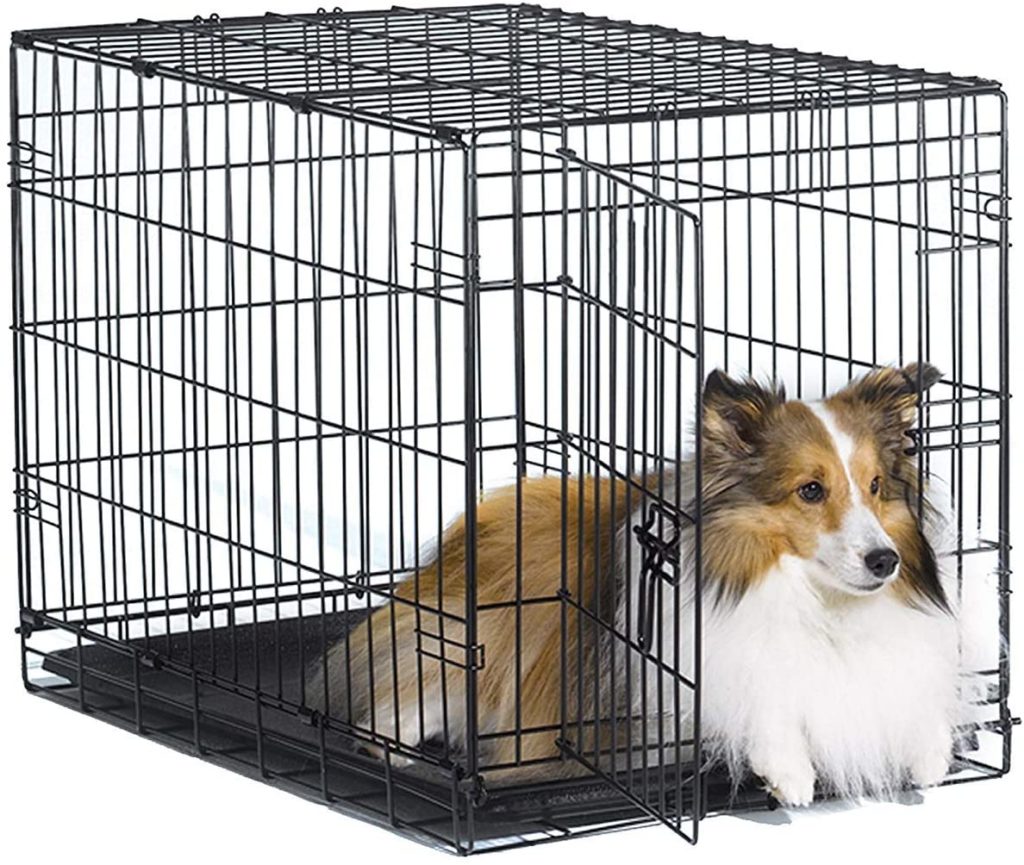
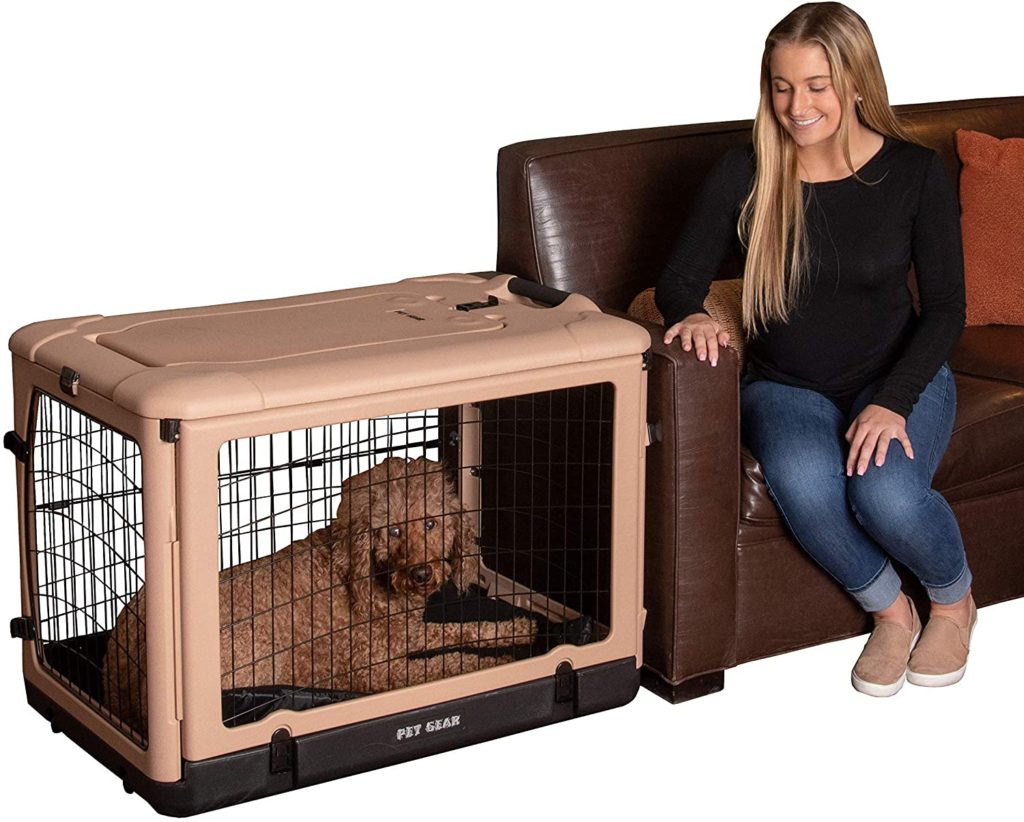
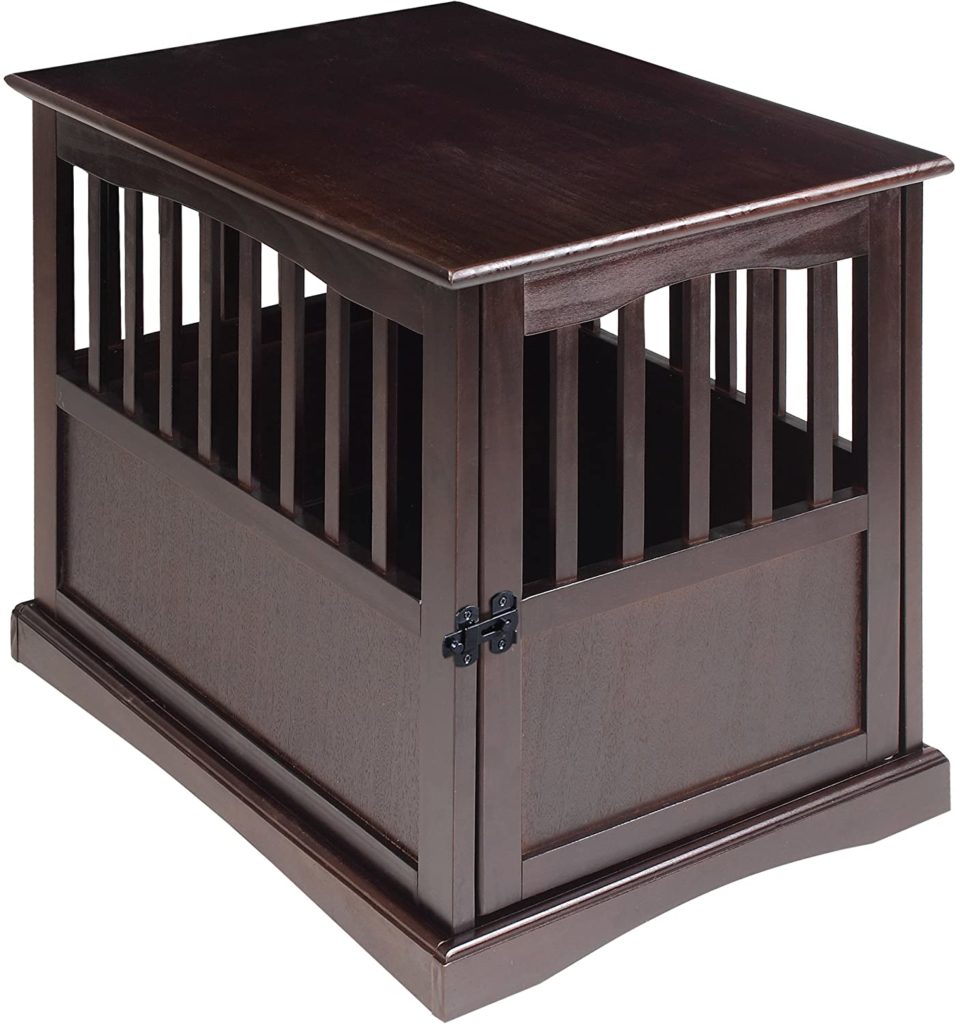
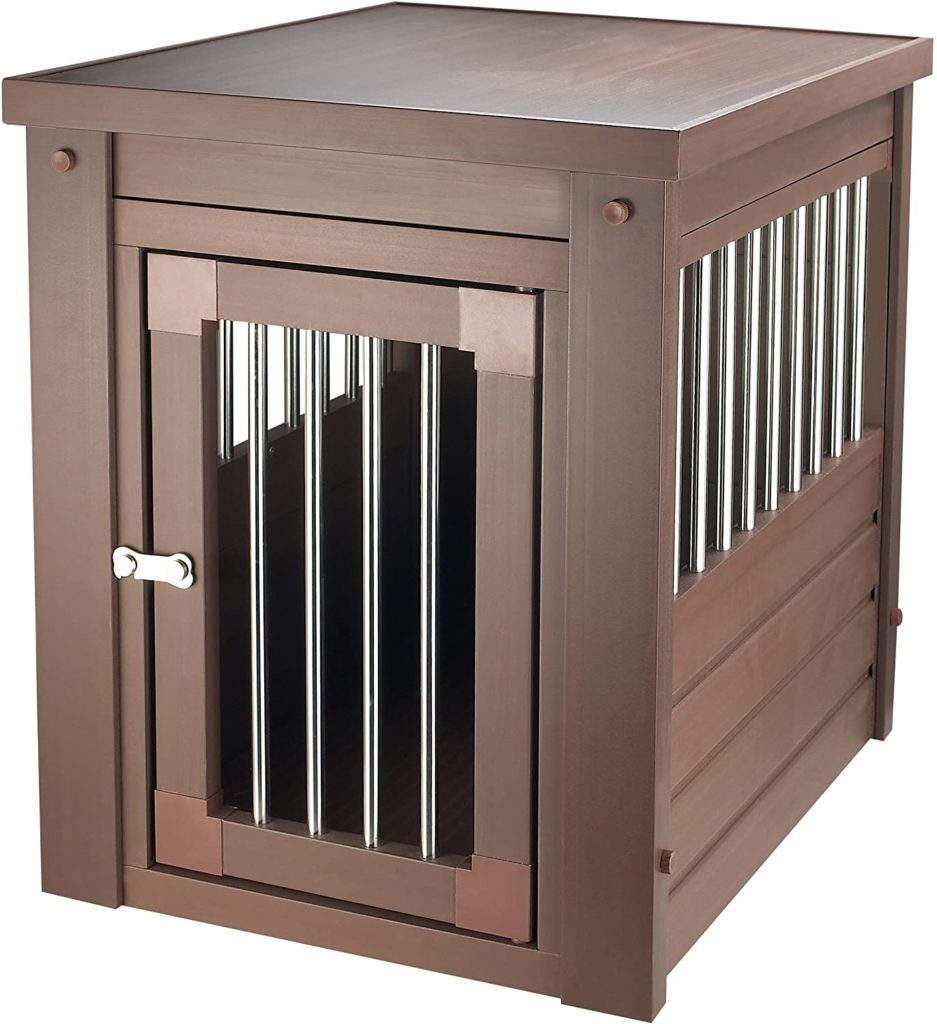




No comment yet, add your voice below!